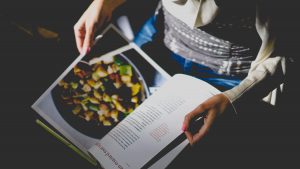Exploring stories through cooking and text creation, a guided inquiry.

Dan Gold, Unsplash.com
This is a guided inquiry around how students can communicate their understanding around a chosen story in a nuanced way. This will be demonstrated by showcasing their key takeaways from a story of their choice, achieved by creating a cookbook that will involve them creating text, taking photos, troubleshooting recipes and noticing culturally embedded biases present in their author’s work. The recipes can be directly taken from the text or can be symbolic representations of the world at a given point in the story. In grade 6, students are expected to begin exploring differing forms of text and how those messages are aided by the medium in which they are represented. It requires higher level critical thinking since students must read a story, synthesize their key takeaways and finally, craft a new piece of literature that is demonstrable of connections to characters cultural identities, relationships, regions and realizations. My expectation is that they will generally have the experience of explaining what they learned from a story, but will need scaffolding in terms of practicing new skill sets to sharpen their critical lens in oral and written communication.
One of the main purposes of this assignment, besides practicing multi-modal approaches to literacy, is to explore the problem of the four f’s (food, folklore, fashion & festival) and find ways to not reduce a story to what one might ‘expect’ the food exploration to be, instead assessing the complexity of characters and the implicit stereotypes embedded in the food discussed in the text. I will ask students to go beyond food stereotypes and find ways to highlight bias throughout their cookbook, casting a critical lens on their aesthetic re-examinations of favourite texts. The final portion is publishing a key recipe from each cookbook into a collaborative portfolio featuring one of each students’ recipe inquiries, and the student led conference will be in the home ec. office so parents can see their child cook a complicated dish and connect it to their understanding of text, audience and biases.
Binging with Babish, a popular youtube channel, takes famous literary tales and replicates the iconic dishes from those stories. Here’s a great one on the danger of cultural bias when interpreting food histories.
In the english translation of this iconic Pokemon episode, the audience is led to believe that the japanese onigiri is instead jelly doughnuts, revealing the deeply entrenched cultural biases and western lens being imposed on its interpretation. A fun one to watch with kids, who doesn’t like food vids and pokemon??
Direct links to BC grade 6 english language arts curriculum
Big Ideas
- Language and text can be a source of creativity and joy
- Developing our understanding of how language works allows us to use it purposefully
A chance for students to demonstrate their love of a particular work of writing (fiction novel, audiobook, cd with lyrics attached, autobiography etc) by creating a new piece of art and writing related to the work. To explore the cultural biases of texts, it is imperative that students explore how the language used by authors to convey a point influences the audience’s perception of the recollection of events, and it is our job as audience to explore our own view of the cultural snapshot being supplied in the text.
Curricular Competencies
- Recognize and appreciate how different features, forms, and genres of texts reflect various purposes, audiences and messages
- Recognize an increasing range of text structures and how they contribute to meaning
- Synthesize ideas from a variety of sources to build understanding
- Think critically, creatively, and reflectively to explore ideas within, between and beyond texts
Students must begin practicing a number of different writing styles to develop an appreciation for how varying modes of communicating knowledge aid or hurt the conveyance of a message to audience. The students need to engage creatively during their reading of a text in order to reproduce a new text themselves that highlights their own unique cultural identity, biases and voice.
Content
- Metacognitive strategies
- Techniques of persuasion
- Reading strategies
Tangible persuasion techniques will be taught, looked for and practiced by students, as well as reading comprehension check ins on their guided literacy inquiry text.
Curricular Integration (pulled directly from BC grade 6 curriculum, see links)
- Media sources can both positively and negatively affect our understanding of important events and issues
- global inequality, urbanization
“How do degrees or urbanization and inequity factor into the recipes present in your story, and how did you critically engage with it in your own cookbook?”
“What are some media biases present in your text? How have you addressed them?”
- Financial literacy- simple budgeting and consumer math
- Introduction to ratios
Students will be expected to budget out their food needs for the experimentation part of their inquiry in the home ec. Room. Each Friday, the class will go onto a grocery store delivery service site (see below) and choose which items they need to have for their recipe explorations. They can work together to share their money to make purchases extend further, and must stay within the $40 budget given to each student (roughly $10 per week, excluding the stores of ‘staple’ items always available to the whole class). They will need to calculate GST and keep a record of their spending, on a spread sheet provided or in their own preferred method.
Tip! For online food ordering, I tend to gravitate towards this program at thriftys.
In terms of ratios, part of one of their recipes should include reference to scaling- either scaling one of their recipes down or up, given them tangible skills in the real-life applications of ratios.
- Influences on food choices “Explore and plan food choices to support personal health and well-being”
“What do the food choices in your story say about the lives of your characters?”
“What do your specific choices for your own cookbook say about your own values reading this text?”
Applied Design, Skills and Technologies
- Food Studies
- “basic food handling and simple preparation techniques and equipment”
- “factors in ingredient use, including balanced eating/nutrition, function, and dietary restrictions”
- “factors that influence food choices, including cost, availability, and family and cultural influences”
This is where the home ec sessions come to shine, since this will be where we practice techniques, as well as examine cultural implications, of certain recipes.
Materials
- Variety of cookbooks
- Notebooks
- Art supplies (construction paper, markers, paint, pens, pencils, sharpies, tape, glue, fabric pieces, scissors)
- Computer access
- Flour, rice, beans, sugar, yeast, spices, pasta, tomato sauce, salt, pepper, oil, baking powder, baking soda, chocolate chips (classroom staples, all can use)
- Budget for each student ($40 a piece, to be rationed across their 4 week inquiry, 4 home ec practice sessions)
- Projector
Environment
- Plan on doing literacy work in classroom, that way students have free rein over available art and text resources for their research
- Practical classes in schools home-ec room for kitchen prep, practice and photographs for cookbooks (once weekly)
Adaptations
- Pradar Willis’, disordered eating and severe allergies
- For children who have a prohibitive relationship to some or all foods, it is essential to provide alternatives in terms of what a ‘recipe’ can look like, and honour the fact that not all recipes are for food consumption.
- Examples of non-food ‘recipes’- garden layout and ratios of plants, ‘potions’ (gotta be one Harry Potter nut, right?), recipes for natural skin and beauty products, ‘mechanical recipes’ (how do a combination of pieces assemble to make a machine?), robot’s diet (make recipes out of nuts and bolts, buttons, etc) THERE ARE SO MANY FUN NON-FOOD RECIPES
 Photo by Anatoly Ivanov on Unsplash
Photo by Anatoly Ivanov on Unsplash

Photo by Anatoly Ivanov on Unsplash
-

Photo by Sharon McCutcheon on Unsplash
- Sensory concerns
- Cannot have hands get dirty or get overstimulated, find kitchens too noisy, extreme temperatures derailing. All of these and more are common concerns for many students in our classrooms. Think creatively about the supports you can give in these moments, working with students to address their sensory needs proactively (rather than retroactively).
- Examples of steps to take- always have noise canceling headphones available and review visual cues prior to entering kitchen to ensure they can still safely participate without hearing. Provide gloves, tools and gadgets to students unwilling to get dirty. For temperature, work with students beforehand to create recipes that honour their temperature preferences, not everything needs to be flambéed to be impressive! Finally, provide knife training and alternative to using knives for those with fine or gross motor difficulties (show videos of expert chefs tearing foods apart with their hands!)
Tip! Noise cancelling headphones are easily found at Dollerama for cheap (~$4)! Well worth the investment, tons of learners use them regularly now to help them stay safe and engaged during lessons.
Extensions
- ‘The nutshell’ blog– have students in need of an extension be your ‘class informant’ to parents at home by blogging about what you are learning about this inquiry and reporting out. This is a great option because students can opt in or out of the blog any week according to their own work load and interest, so families get multiple perspective on the classroom learnings.
Assessment
1) to plan for students and ensure they are meeting their potential
2) to identify where the program and environment might be adjusted to meet individual needs
3) to share appropriate information with students, families, and other school personnel
- Interactive student workbooks as model for cookbooks (excellent exploration of ways to teach this effectively available here , provided by Nick Kruk, Dane Sweeney, Hailey Yan & Katrina Crawshaw)
- Weekly sore knee conference with each student to guide inquiry (see conferencing handout, provided by Denée Nickel, Kelly Wakeham, Emily Shorthouse and myself)
- Core competency check-in at beginning and end of project (six cedars model)
- Centre rotations of cooking techniques, cleaning and transcription practice, foundational assessment
- Exit slips (see Anne Davies ‘Making Classroom Assessment Work (2017)’ for examples)
Final assessment moment- Student Led Conference (see notes in ‘LEARNING PLAN’)
Learning Plan structure:
For this learning plan, teachers will present the students with a list of possible inquiry-lessons that they choose as a class to pursue (can do all of them, just half, add new ones to the list). This is to give a structure to their inquiry without being too imposing around key learnings. I will require two lessons, the ‘Four F’s’ and ‘Goes According to Plan’ to ensure the main critical literacies I want them to engage with throughout the process are scaffolded deeply enough for them to create complex and intellectually exciting content by the end.
- ‘Knife day’– learning knife techniques, sharpening, proper cleaning procedures, heat safety with ovens and more.
- ‘Around the world in 80 cookbooks’– Students and teachers alike bring in as many cookbooks as they can (allow for youtube clips, articles, recipe cards, any and all recipes qualify!) and have a flex period where kids look through all the sources in the class and compile ideas for the types of writing styles and visual aesthetics they think will serve them well in their own cook books.
- ‘Flying pigs and scandalous foods’- Research day on the news stories, urban legends and more surrounding the food and location of their story.
- ‘Fashion, folklore, festivals and FOOD’– a deep, critical dive into appropriation vs. appreciation and the message conveyed when we highlight or downplay certain foods. We will talk racial dynamics, globalization and urbanization and its impact on author and audience’s engagement with text, particularly when highlighting a certain cultural context. Taught primarily through think-pair-share and group discussions, play Binging with Babish video.
- ‘Goes according to plan: budgeting and meal prep for the emerging chef’– where they WILL use this math later in life. Teaching how to budget around meals, buying ingredients and planning portions, which could go as far as needing to convert quantities and combine ingredients with other kids. I think giving a model of how to effectively budget is valuable in this case for students who need that support with a follow-able budget sheet, but make sure to let kids choose their own budget format if they prefer! So long as they can provide evidence of their long term financial planning.
- ‘Fantastic feasts and where to find them: creating your own recipes’- this lesson will be asking students to pick one of the foods in their book and imagine how that recipe might look. No wrong answers! They can draw the ingredients they want or can write exact oven temperatures and grams, whatever they need so long as they are getting their thoughts on how to start out of their head and trusting their own process! You can help them troubleshoot later… This is purely a creative session! Give tons of art supplies, free movement around spaces and access to any books they like (no digital reference just yet!)
The first week will focus largely on setting up expectations and procedures, particularly around kitchen etiquette and safety. The following weeks the real creativity is unleashed, while also having a few pillar lessons to ground the work in curricular goals.
After 5 weeks, each student will lead a student-led conference for their families where they cook one of their recipes and explain their inspiration while they work, and once each child has finished they can share their food and enduring wonderings with their family and teacher. The cookbook they have been working on for over a month will have ample evidence of their learning for assessment purposes, provided that you incorporate sections of it into each lesson you undertake (eg. Cookbook day you have students create an entry on how the style in one cookbook may have influenced their choice in a particular section or recipe).
After the unit, the teacher is to take each of those individual recipes shared by the student during their conference and compile them into a class cookbook that they can all keep afterwards. Make it pretty! Make it well-bound! Make it un-throw-out-able!
